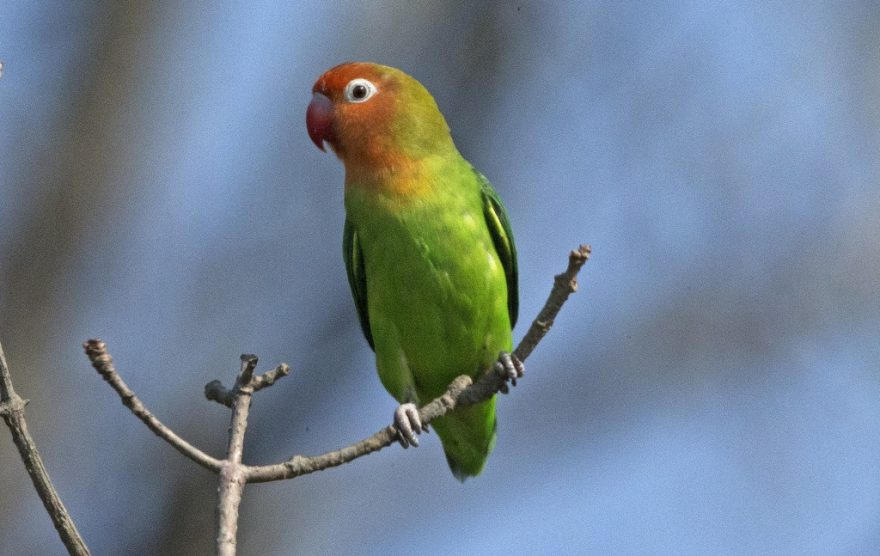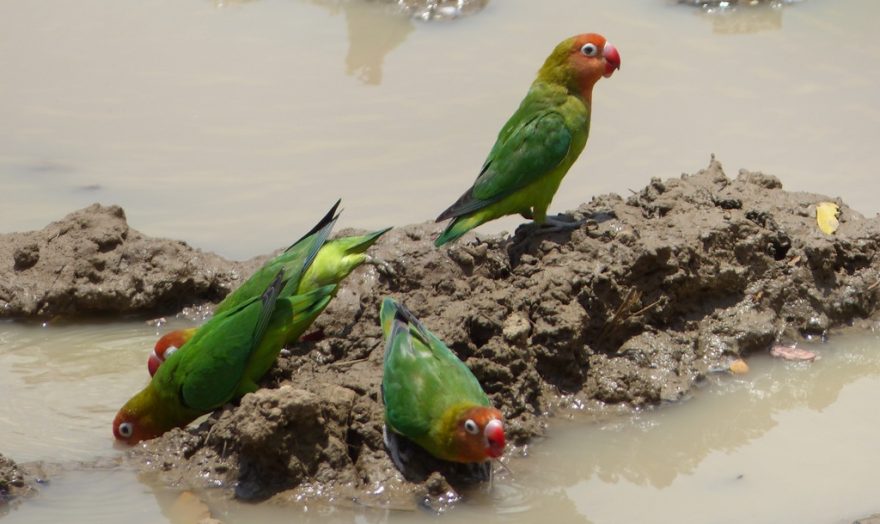The Nyasa lovebird—known also as Lilian’s lovebird—is a species of small parrot native to Malawi, Mozambique, Tanzania, Zambia, and Zimbabwe. They are uncommon in aviculture because of the difficulty many breeders experience trying to breed them. At 13cm (or 5 inches), Nyasa lovebirds are among the smallest parrots kept in aviculture.

Housing & Compatibility
Nyasa lovebirds are less aggressive than the more commonly kept Masked, Fischer’s, and Peach-faced lovebirds; but are still too aggressive to be kept with other types of birds. Best breeding results are achieved with single-pair aviaries, but they also do well in small colonies in a decent-sized aviary—but only if the number of males and females is equal.
Young birds will need to be moved to a second aviary once they become independent, as they will be attacked by their parents and/or other birds in the colony.
An adequate amount of flying space is necessary to ensure good fitness and minimal stress. Perches placed at opposite ends of the aviary will maximize the amount of exercise received. Non-toxic leaves and branches should be provided for chewing. They will be destructive to foliage in a planted aviary.
Lovebirds make an enormous amount of mess, making concrete the best flooring option. The floor should be loosely littered with nesting material (straw, hay, dried grass) and pieces of cuttlefish bone. The ground will need to be swept roughly once a month to remove discarded seeds and foliage that the birds have shredded.
Nyasa lovebirds cannot be housed with other species in the Agapornis genus (the lovebird family) as they will interbreed, producing worthless hybrids that pollute the captive gene pool.
Nyasa lovebirds are less tolerant of cold conditions than other lovebird species, so an aviary that offers some protection from the elements is recommended.
Diet & Feeding
A quality small parrot seed mix forms the basis of the Nyasa Lovebird’s diet. Seed should be offered alongside a varied mix of fruits and vegetables, such as apple, pear and corn. Leafy green vegetables are essential; silverbeet (chard), bok choy, kale and endive are particularly enjoyed.
Many breeders prefer to feed pellets instead of seed. Pellets provide a more balanced intake of vitamins and minerals and produce less waste. Commercial supplements such as egg & biscuit mix can be added to the diet to provide additional protein during the breeding season.

Breeding
Nyasa Lovebirds construct a nest from leaves, palm fronds and straw. Some birds will simply pile all of the nesting material into the bottom of a box and lay eggs on the top, while others will construct elaborate tunnels and chambers. Palm fronds increase the humidity of the nest and improve egg hatch rates.
Commercially produced lovebird nesting boxes are the preferred nesting receptacle used by most breeders, however some prefer to use hollow logs. There should always be significantly more available nests than pairs of birds in an aviary to minimize territorial disputes.
Lovebirds will begin mating with a suitable partner at roughly one year of age. The hen will lay 3-5 eggs approximately one week after mating, which will then be incubated for three weeks. Typically; only the female will incubate the eggs, but males are known to occasionally contribute.
Once the young hatch, both parents will feed the chicks in the nest for approximately a month. Young birds become independent six to eight weeks after fledging. The young should be removed shortly after becoming independent to prevent aggression from the parents.
Though the bond between pairs is strong, if their partner dies they will usually mate with a replacement the following year. The new bird should be introduced almost immediately.
Hens should be preventing from breeding more than three times a year. Overbreeding leads to a reduced lifespan and smaller, poorer quality nests.
Sexing
Male and female Nyasa lovebirds have identical plumage, making visual sexing almost impossible. DNA sexing is the most reliable way to accurately determine a bird’s sex.
A popular way to guess a bird’s sex is by feeling the distance between the pelvis bones. In males, the distance is typically 1–3 mm while measuring 6–8 mm in sexually mature females.
The observation of subtle behavioral differences can also be used to determine a lovebird’s sex. Females are often more aggressive and loud than males. They are also more likely to begin construction of a nest, or construct a nest while not part of an established pair.
Mutations
Numerous color mutations are available in aviculture with varying rarity and value. Because lovebird species interbreed so readily, it can be difficult to differentiate between a hybrid bird and a legitimate color mutation.
Health
A strict worming and parasite control regime is essential to maintain the long-term health of all captive birds.
A healthy Nyasa lovebird has a life expectancy of ten to fifteen years.
Can you breed a Nyasa with a fisher or mask
They will breed together, but you should let them. Check out out articles What are hybrids and why should I avoid them? and African Lovebird species in Australian aviculture.